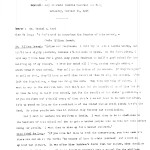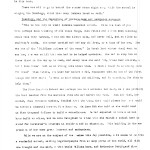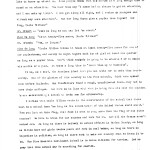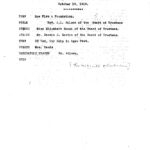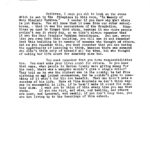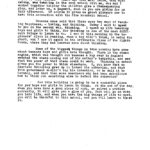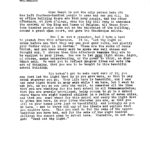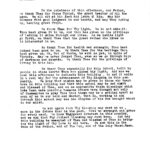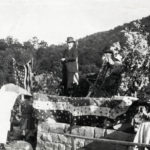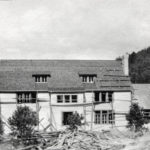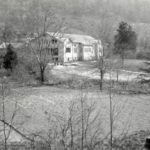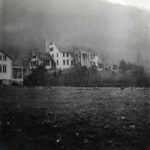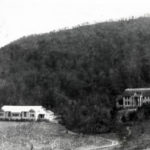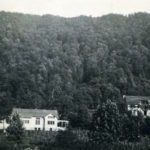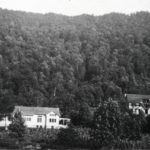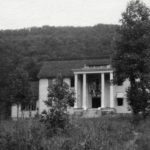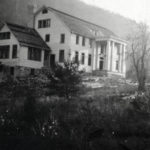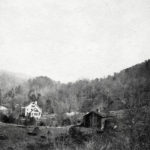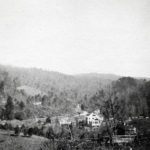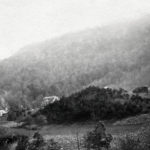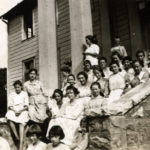Pine Mountain Settlement School
Series 10: BUILT ENVIRONMENT (Physical Plant)
Mary Sinclair Burkham Memorial School House I
November 1917 – January 1919
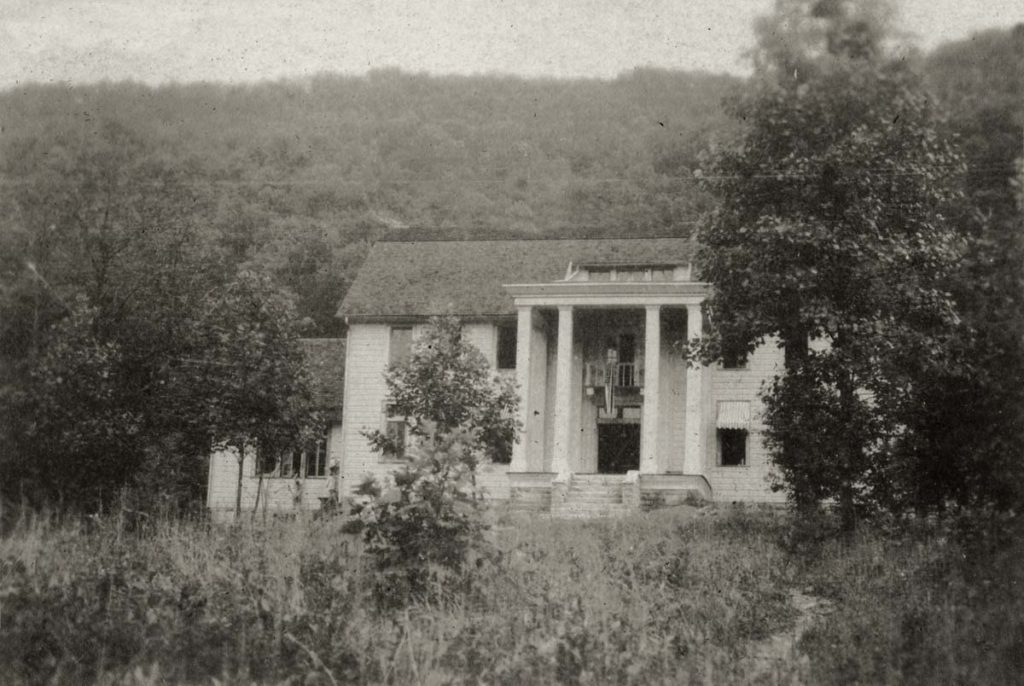
Burkham School House I. Angela Melville Album II, Part I. “1st M.S.B. Schoolhouse,” c. 1918. [melv_II_album_010.jpg]
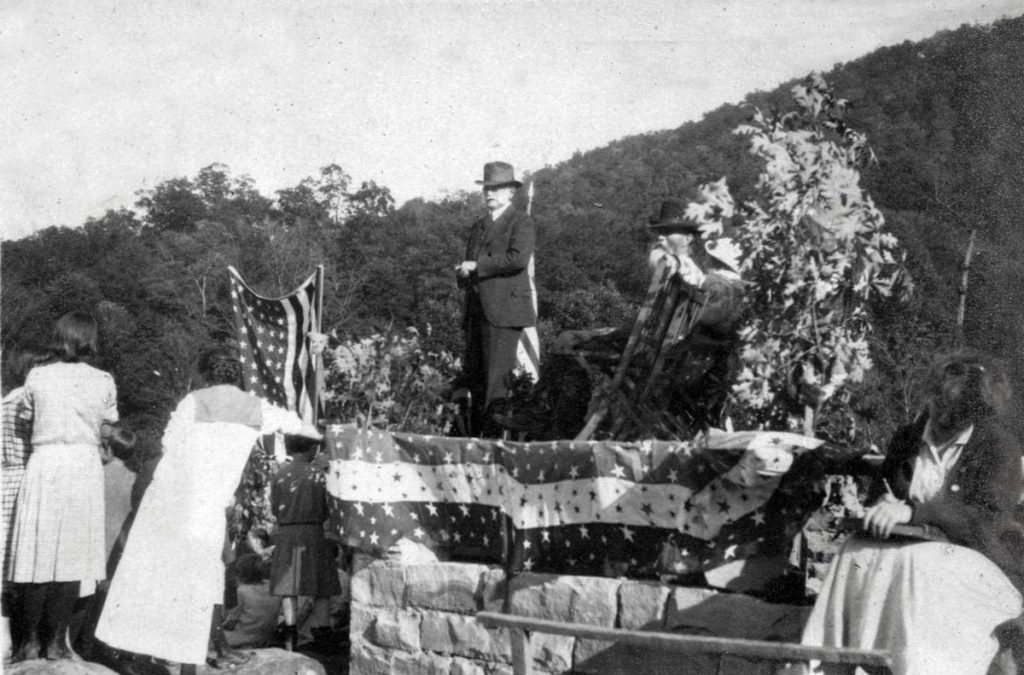
Daniel Lord. Ethel de Long Zande, and William Creech offer remarks at the 1917 dedication of Mary Sinclair Burkham School House I. [melv_ii_album_054x]
MARY SINCLAIR BURKHAM Memorial School House I
November 1917 – January 1919
OUT OF THE ASHES
The Mary Sinclair Burkham Memorial School House I at Pine Mountain Settlement School was dedicated on Thanksgiving Day 1917. It burned on January 23, 1919. It served many functions in its approximate fourteen months’ of existence. In keeping with the donor’s wishes, Caroline Burkham of New York, who donated money for the building in honor of her sister, the building was to serve many functions on the campus. It’s most important function was dedicated to the education of mountain children in the surrounding area.
The estimated worth of the building was given as $18,000 at the time of its destruction by fire in January of 1919. Unfortunately, the insurance only covered $10,000 of that value. Construction of a new building would cost far more but would also re-site the structure so it would not endanger any other building if it also caught on fire. Out of the ashes of that early tragedy came a new school house, Mary Sinclair Burkham School House II, and a renewed determination to build an educational program that would serve the Community and stand the tests of time. Mary Sinclair Burkham School House II was also consumed by fire in 1984. Out of this and other such tragedies, Pine Mountain Settlement School continues in its 112th year to move forward. Today we give thanks for the resilience of people for a continued belief in community and in an institution that is dedicated to service, to successful educational programming, and to the power of shared good ideas.
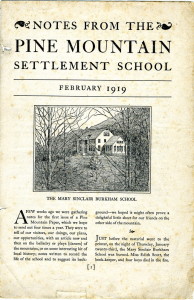
Inaugural issue of the Pine Mountain Notes describing the Burkham I fire. [PMSS_notes_1919_001.jpg]
On the evening of Thursday, January 23, 1919, the Mary Sinclair Burkham Memorial School House I burned to the ground. It was a tragedy of enormous proportions. The life of the school’s bookkeeper, Miss Edith Scott, and four young boys were taken by the fire. Miss Scott was the acting housemother of the small group of boys assigned rooms in the Burkham School I building. Space was sought in all the buildings at the school to house the growing population of students and staff while appropriate residences were under construction. Six of the schoolhouse classrooms were in use for temporary quarters for four workers and sixteen young boys. Some of the classrooms chosen as sleeping quarters were on the upper level of the two-story building.
The students who perished in the fire were Landis Hall, Elbert Walker, Birchel Harris, and Almon Huff. The fire was fierce and consumed the building in less than an hour.
The events are described by Ethel de Long in the first issue of the newsletter, Notes from the Pine Mountain Settlement School, dated February 1919, as follows:
The fire broke out about half past two and even the people who wakened barely escaped with their lives, as practically the whole first floor was in flames when the alarm was first called. Miss Scott, a deaconess of the Methodist Church, who was with us during a year’s leave of absence, had been ill for two weeks. It is certain that she and the three boys, … if awakened at all, could have had only a second’s consciousness, as the smoke was terrific. The fourth boy, Almon Huff, sixteen years old, was praying by a window while the other boys were climbing out and begging them to go back with him down the hall to save Miss Scott. He did not know that it was then altogether impossible to save her, and his own few seconds’ chance of escape went by. We laid away in a common grave, on the hill near Uncle William Creech‘s grave, the few unidentifiable ashes of the three boys. Miss Scott and her little knight, Almon, lie side by side. As we knelt in the warm sunshine that Saturday afternoon, some sense of peace came to us from the knowledge that we could always associate with their graves not the fright and horror of the fire but the nobility of a boy’s dying thought in a moment of utter peril.
We had scarcely time to wonder what the attitude of parents would be before they came to reassure us — kinfolk from nearly every home represented in our school. They came to learn of their children’s safety and they became our chief comforters. “Take my children away?” said the father of three. “They can’t be safe anywhere, and if I took the home death might come to them in the same way, and they growing up with no knowledge. We must all take the chance of dying, and I’d rather have mine die while I was doing the best I know for them than keep them back in darkness all their lives, so I could feel easy about them. Many others said, “No one faults the school. You do your best and we trust you.”
An hour after daybreak on that morning, a father from thirty miles away, who had applied the day before for a place for his fourteen -year-old girl, came from the neighbor’s where he had slept, to say, “I’m worried to know if I still can enter Allene on Monday. We were feared you’d have to close school and she’d have to go home.”
As a matter of fact, the two younger classes had school the morning of the fire. Within two days new text-books and school supplies were on their way, and the school work began regularly on Monday.
We do not know the cause of the fire or exactly where it started. The building was steam-heated, the chimney was cemented solidly inside, all the workmanship being first-class. Without our reservoir and our water works, finished last summer, we could not have saved Laurel House. The workers and children showed remarkable calmness and presence of mind, and there was no hysteria before a fire so fierce that it consumed the whole building in three-quarters of an hour.
Courage must be our word. A fourteen-year-old girl, looking mournfully into the ruins, said: “Of course we can stand it. This is just nothing when you think of what France has had to bear for four years.” Out of our own personal tragedy we must, as the rest of the world is doing, snatch some pure gold of the spirit, stronger faithfulness, deeper love, clearer vision. Our dead must not have died in vain.
ETHEL DE LONG TO KATHERINE PETTIT Account of the Fire
(De Long was not on campus at the time.)
We were so glad anyone got out of the School house. The fire spread with such fearful rapidity that it seems miraculous that people could get out at all. Not three quarters of an house after the fire started, the building was all gone.
MARGUERITE BUTLER Account of the Fire
Marguerite Butler, a staff member, participated in the efforts to save the building and records her personal experience in a letter home to her mother just after the fire.
LETTER 1B – Saturday morning, [January] 1919 – [images 042-049]
Dear Mother — I wonder if you have heard of our terrible loss — the school burned to the ground and Miss Scott [Edith Scott], our bookkeeper and four children were burned in it. I will never forget it to my dying day — it was the most terrible experience of my life.
For the past two weeks I have been sleeping on Miss Gaines‘ [Ruth B. Gaines] porch, she in her room. About 2:30 Friday morning I was awakened out of a sound sleep by the crackling and honestly when I sat up in bed and saw the flames leaping out of every window in the library for a second I couldn’t move. I called Miss Gaines very quietly – she said she couldn’t move – she knew she must not faint and that she must get her control.
I dashed to awakened children telling them to dress immediately, the schoolhouse was on fire and not one word. A couple got hysterical and I simply forced them to be quiet. An outsider would have thought I was stone-hearted. Then I tore to ring the bell, dressed myself and collected every bucket in the house, scrubbing, water, anything I could get.
We knew school house was beyond saving, for ten minutes after I was up the entire building was in flames. Honestly for awhile it seemed as if nothing in the world would save Laurel House. Miss Benedict [Imogene Benedict] with a crowd of children filled buckets in the laundry and as fast as they could go threw water all over back part of house. They worked like troopers as hard as they could for an hour. I had three throwing water on side porch and front part of house while I with two boys and Benjie worked on the upper roof of porch and roof of house.
Miss Gaines was so weak she didn’t even dress, just stood upstairs wrapped up in a blanket. The big hose hung in the lower hall of school house and couldn’t be gotten out. The stone tool house just behind school house that they were building for it was not quite finished. We got a short hose from barn that reached back roof but not highest part so Irving got on top and we passed water up the roof to him in buckets. If we hadn’t running water there wouldn’t have been one chance in a million. I hope Mrs. Emery [donor of reservoir] will know just what the reservoir meant.
Early in the evening there was a high wind but luckily the flames went straight up into the air and then a current of wind took the cinders directly south, so they say far side of mountain is covered.
It never entered my head that everyone in school wouldn’t get out. Mr. Zande and I heard it about same time and apparently before anyone on the place, even before those in very house. When Mr. Z arrived he told the boys to jump for their lives. No one knows how it started but we think it was possibly instantaneous combustion because they oiled walls [generally a mixture of linseed oil and shellac] of library that day and it was there only I saw the flames at first. Then they swept the entire halls, up and down, so when the children awoke they had no chance of getting out. The boys all jumped. Alman [Huff] made his way thru the hall to Miss Parkinson’s [Marguerite Parkinson, teacher, housemother] room, awakened her and she jumped from the balcony. Then he went to help Miss Scott [Edith Scott, bookkeeper] and evidently couldn’t find her door for his skull was found just near Miss Scott’s door. The other three children, Elbert (Emily’s brother), Landis Hall (May’s cousin) and Burchel Harris (Enoch’s brother) they don’t think even wakened. I guess you remember Burchell for he came to Cincinnati. Almond [Huff] was Becky May [Huff]’s brother.
It still seems like a terrible nightmare. I can’t realize it is true. Four of the boys, Dillard Coy and two of Delia’s nephews were burned quite badly, and every other but one was hurt. John D. was terribly cut up and we thought Raymond and Chester had broken arms and legs but the doctor came yesterday and he said they were no serious injuries. Marguerite Parkinson [teacher and housemother] lost her mind for a time that night and they thought broke her ankle but it was only a sprain.
You have no idea the heat of the fire. Laurel House fairly steamed. I didn’t stop to think how near it was to going for my only thought was it could not go and we must not stop throwing water. Of course, thru this we knew no lives were lost and it was a good thing. I heard Emily coming simply sobbing and went to meet her. She simply threw her arms around me and just held as tight as she could. She said she could stand it for her sake but not for Polly, her mother.
From that hour on till daylight I had my hands full with Emily and Becky. The others started wailing too and I just made them stop. I know Miss M [Angela Melville?] shall thought I had no feeling but it made it so much harder for Emily & Becky. At dawn I sent a note to Columbus [Creech] asking if he could take Emily home on mules right away and do you know they didn’t know a thing about it until then. Not a person knew and could come to help us.
We were afraid for Mrs. Zande too but she stood it well. Mr. Zande just cried like a baby. From 3:30 on Mrs. Zande and Evelyn [Evelyn Wells] wrote letters and sent telegrams and sent __________________ over to make early train. He did and got the doctor.
We tried to go along yesterday same as ever. For two younger classes there was school in B.L.H. [Big Log House] living room. Monday regular school begins in every living room. Celia [Cathcart] left Thursday about the road to Frankfort and it is a good thing for it may have meant another life. Mrs. Z[ande] telegraphed her to bring in office supplies and books for school Monday.
Really the spirit is wonderful – no thought of discouragement, except of course the knowing of lives gone — just plans for the future. Evelyn Wells in her gown and [not?] without a stitch on saved many things from office — rolled safe to door and threw it from steps, got 2 typewriters, office catalogues, etc. Nothing was saved but from there.
By 7:30 yesterday morning the office was installed in corner of canning room and Evelyn was typing away. It is a wonderful school.
This afternoon we are having services and burial next to Uncle Wm’s [William Creech died May 18, 1918].
Had a note from Pat that Kit was very ill with pneumonia. It came last night on top of everything else.
Will write again in a few days. Thought this may get in Cin[cinnati] papers.
My love, Marguerite.
Burkham Memorial School House I: PLANNING ITS REPLACEMENT
Mary Rockwell Hook, the school architect immediately made plans to come to Pine Mountain in February to begin the process of planning a second building to take the place of the burned structure. The destroyed building had housed six offices, four classrooms, a workshop, a sewing room, a library, and a large play-room. Six additional classrooms had housed the victims of the fire and twelve others. Miss Hook planned the new building to be the same memorial to Mary Sinclair Burkham as the earlier structure and made few changes to the second structure. She envisioned that it would contain the core of the classroom space for the school and also serve as an office building and, again, provide dormitory space for twenty-four boys. Only part of this second plan was realized in the new Burkham School House II.
Burkham Memorial School House I: HISTORY
![Angela Melville Album II, Part I. "1st M.S.B. Schoolhouse"[melv_II_album_010.jpg]](https://pinemountainsettlement.net/wp-content/uploads/2015/05/melv_II_album_010-150x150.jpg)
Angela Melville Album II, Part I. “1st M.S.B. Schoolhouse”[melv_II_album_010.jpg]
Burkham School House I was dedicated on Thanksgiving Day 1917. It served many functions in its approximate fourteen months’ existence and had honored the wishes of the donor, Caroline Burkham of New York, who gave the money for the building in honor of her sister, Mary Sinclair Burkham. The estimated worth of the building was given as $18,000 at the time of its destruction. Unfortunately, the insurance only covered $10,000 of that value. Construction of a new building would cost far more but would also re-site the structure so it would not endanger any other building if it also caught on fire.
Burkham School House I was built on the rise of land, just to the west of (old) Laurel House I, which was still under construction at the time of the schoolhouse fire. While Old Laurel House I was saved, it would also succumb to flames many years later and out of its ashes would rise another Laurel House II, the building that today dominates the campus. The struggle to maintain all-wooden structures at the School is a challenge and that challenge continues as Pine Mountain completes its 103rd year. Workshops that explore preservation techniques for historic structures are an important part of Pine Mountain’s ongoing programming. Please check the schedule for Pine Mountain’s upcoming workshops at pinemountainsettlementschool.com, if you are interested in participating.
GALLERY I: Burkham I Cornerstone Laying Remarks
Much of the indomitable spirit of the school is captured in the remarks of Uncle William Creech and Ethel de Long at the laying of the cornerstone for Burkham School House I in 1916:
- Burkham School House I. Laying of cornerstone, October 1916, page 1. [laying_cornerstone_burkham001]
- Burkham School House I. Laying of cornerstone, October 1916, page 2. [laying_cornerstone_burkham002]
- Burkham School House I. Laying of cornerstone, , October 1916, page 3. [laying_cornerstone_burkham003]
*NOTE: Page 2 is cropped.
GALLERY II: Burkham I Cornerstone Laying Dedication
- [burkham_I_dedication_001]
- [burkham_I_dedication_002]
- [burkham_I_dedication_003]
- [burkham_I_dedication_004]
- [burkham_I_dedication_005]
TRANSCRIPTION: Burkham I Cornerstone Laying Report
[page 1]
Report of the
Laying of the Cornerstone of the
Mary Sinclair Burkham Memorial Building
Wednesday, October 11, 1916
Prayer: Mr. Daniel M. Lord
Miss de Long: “I don’t need to introduce the founder of this school, –
Mr. William Creech: “Ladies and Gentlemen: I will try to talk a leetle to-day, but hit’ll be a might poor talk, because I’m not able to speak. In the first place, I will say I have been for a great many years desirous to build a good school for the building up of my country. I have invested all I have, pretty near, in making a start to build this school. They call me the father of the school. If they’re agoin‘ to call me that, they’ll have to call Miss Pettit and Miss de Long the mothers. I’ve laid the foundations, – they are doing the work. They have the help of others. I want to say to the children here that hit’s not for the benefit of me of Miss Pettit or Miss de Long to build this school, but for the benefit of the risin’ generation, – of you children and them all over; of them that’s here and them to be born hereafter. It’s to stand as long as the constitution of the United States shall stand; that’s the deed. No other people can take it without they destroy the constitution.
Now I want to lecture the children a little. I want them to be in obedience to the teachers of this school and try to gain a better people than we have had here before among our people. I want them to rise up for a better standard.”
Miss Ethel de Long [Zande] : “If you have had time to read the cornerstone, you have seen that there are cut on it the words: “In Memory of Mary Sinclair Burkham.” And I have in my hand her picture. It was after Miss Burkham’s death that her sister, Miss Caroline Burkham, decided there could be no lovelier memorial than a school for the children of the mountains. And this picture is to go in behind the stone, together with a little book which is very very interesting to Miss Pettit and to me, and the accounts of her burial as they were printed in the New York Papers.
[page 2]
In 1906 Miss Mary Burkham was one of the founders of a society in New York to help in the education of children. She kept the records of the business meetings in this book.
These are all to go in behind the corner stone right now, while the school is singing the Doxology, which Miss Mary Burkham loved so well.”
Doxology, and the depositing of pictures, book and newspaper accounts
“This is the Mary Sinclair Burkham Memorial School. While the rest of you have perhaps been thinking of all these flags, Miss Pettit and I have been thinking about Miss Mary Burkham, – how she was always sick, and never well, yet so alive to children’s needs. She never married and had any children, or a home of her own. She was one of the “Childless mothers of the race.” In March last winter when I went to see her, she was so ill that she had to be helped upstairs. She had to stop two or three times on the way up to rest, and every time she said “Oh, those dear children, – how I love them! Tell me something more about them. I wish I could do something more for them.” Miss Pettit, who knew her before I did, remembers that as one of the first things she ever said: “I want to know about the children, and do something for them to help them.”
The Pine Mountain School was perhaps the last school in her mind, as I was probably the last teacher from the mountains whom she saw before she died. When she died, her sister, Miss Caroline Burkham, decided that the thing that would please her most would be to have a memorial here at Pine Mountain. On June 6th she told us she would send us five thousand dollars to build a school house. We had expected to have a school house built sometime, but we were delighted to think that she wanted a school here to stand for her sister’s interest in children and in education. This building is the expression of her very great interest and enthusiasm.
While we are on the subject of what makes this day possible, – it seems to me this a wonderful school, calling together people from so many parts of the world, all with one thought and one mind, – that Uncle William here, and Katherine Pettit, and Miss Burkham by reason of her interest and sympathy, should somehow have gathered at this school. From all corners of this country our school has gathered help. You see we have this common idea, the American idea that “you can trust men if you will train ..[PAGE CROPPED]
[page 3]
sure of its strength and sure of its beauty when it is grown.
Little boys and girls should have as good a chance as the poplar trees. We like to hurry up education. Some people think that six months is a long enough time to spend on an education. You hear them say “I never had no chance to get an education, and I can make my livin’, I can get along all right, and I reckon my younguns can without any more education”. But how long do you give a poplar tree to grow? How long, Uncle William?”
Mr. Creech: “Jest as long as you can let ‘er stand.”
Miss de Long: “About twenty-five years, Uncle William?”
Mr. Creech: “Yes, or longer.”
Miss de Long: “Uncle William thinks it takes at least twenty-five years for one of our poplar trees, and surely we ought to give each boy and girl at least one quarter as long as a poplar tree. Don’t think anybody is going to be educated if he stays six months or a year. It takes a long time to ‘train them up to humanity’ ”.
It is, as I said, the American ideal that you can train men to make them trustworthy. One of the glories of this country is its free schools, which were opened even before England’s. Our forefathers found a rough, uncultivated land – they had to leave their colleges. Our work is in line with what is being done all over the country. We are establishing a school to train men for citizenship.
I notice that Uncle William wrote in the constitution of the school that there must be a school here “as long as the constitution of the United States shall stand.” When you look at this flag, what does it mean to you, more than the flag of any other country? We have to train for our country and work for it. And all the dreams aren’t worked out. As long as there is bribery in school affairs in Harlan County, a long as little boys and girls twelve years old work in coal banks, as long as there is injustice in politics, so long is there work to make our country what we dream it to be. The Pine Mountain Settlement School is to raise citizens for America. Let us pray that this school may do something for America.
Uncle William, will you please hold the flag so that the children can give flag salute?
Salute to flag followed by talk by Mr. Daniel M. Lord of Chicago
GALLERY III: BURKHAM Memorial School House i
- Mary Sinclair Burkham School House I. Laying of the cornerstone, October 1916. [ii_12-02_burkham_0424]
- Mary Sinclair Burkham School House I.
- Mary Sinclair Burkham School House I.
- Mary Sinclair Burkham School House I.
- Mary Sinclair Burkham School House I.
- Mary Sinclair Burkham School House I.
- Mary Sinclair Burkham School House I.
- Mary Sinclair Burkham School House I.
- Mary Sinclair Burkham School House I.
- Mary Sinclair Burkham School House I.
- Mary Sinclair Burkham School House I.
- Mary Sinclair Burkham School House I.
Return To:
BUILT ENVIRONMENT
BUILT ENVIRONMENT Guide
See Also:
BUILT ENVIRONMENT Architectural Planning SCHOOL HOUSE I
de LONG – ZANDE PAPERS: Letters to her family. January-April 1919.
[see January 24, 1919]
MARY SINCLAIR BURKHAM Memorial School House II
|
Title |
Burkham School House I |
|
Alt. Title |
Mary Sinclair Burkham Memorial School House I |
|
Identifier |
|
|
Creator |
Pine Mountain Settlement School, Pine Mountain, KY |
|
Alt. Creator |
Mary Rockwell Hook, Architect |
|
Subject Keyword |
Burkham School House I ; Mary Sinclair Burkham Memorial School House I ; Pine Mountain Settlement School ; Pine Mountain, KY ; Harlan County, KY ; fire ; Miss Edith Scott ; bookkeepers ; housemothers ; classrooms ; students ; student housing ; Landis Hall ; Elbert Walker ; Birchel Harris ; Almon Huff ; Ethel de Long ; Notes from the Pine Mountain Settlement School ; William Creech ; graves ; parents ; Reservoir ; Laurel House ; Mary Rockwell Hook ; architects ; sewing rooms ; libraries ; playrooms ; Mary Sinclair Burkham ; dormitory spaces ; Burkham School House II ; dedications ; Caroline Burkham ; gifts ; insurance ; Old Laurel House ; Laurel House II ; |
|
Subject LCSH |
Burkham School House I — Pine Mountain Settlement School (Pine Mountain, Ky.) — History. |
|
Date Digital |
2001-05-27 ; 2013-09-11 ; 2013-09-21 ; |
|
Publisher |
Pine Mountain Settlement School, Pine Mountain, KY |
|
Contributor |
Mary Sinclair Burkham ; Caroline Burkham ; |
|
Type |
Collections ; text ; image ; |
|
Format |
Original and copies of images, documents, and correspondence in file folders in filing cabinet ; Image/JPEG Collection of Photographs ; photograph albums ; |
|
Source |
Series 10: Built Environment (Physical Plant) |
|
Language |
English |
|
Relation |
Is related to: Pine Mountain Settlement School Collections, Series 10: Built Environment (Physical Plant) ; Kentucky Virtual Library collections <http://www.kyvl.org/> [searchable] |
|
Coverage Temporal |
1916 – January 23, 1919 |
|
Coverage Spatial |
Pine Mountain, KY ; Harlan County, KY ; |
|
Rights |
Any display, publication, or public use must credit the Pine Mountain Settlement School. Copyright retained by the creators of certain items in the collection, or their descendants, as stipulated by United States copyright law. |
|
Donor |
n/a |
|
Description |
Core documents, correspondence, writings, and administrative papers about Burkham School House I ; clippings, photographs, books about Burkham School House I; |
|
Acquisition |
Constructed 1916-1917 |
|
Citation |
“[Identification of Item],” [Collection Name] [Series Number, if applicable]. Pine Mountain Settlement School Institutional Papers. Pine Mountain Settlement School, Pine Mountain, KY. |
|
Processed By |
Helen Hayes Wykle ; Ann Angel Eberhardt ; |
|
Last Updated |
2002-07-01 hhw ; 2004-11-30 hhw; 2013-09-21 hhw ; 2013-11-11 hhw ; 2014-05-13 aae ; 2016-11-23 hhw ; |
|
Bibliography |
Source “Burkham School House I.” Series 10: Built Environment (Physical Plant). Pine Mountain Settlement School Institutional Papers. Pine Mountain Settlement School, Pine Mountain, KY. Archival material. Marguerite Butler Letters. January 1919. |

